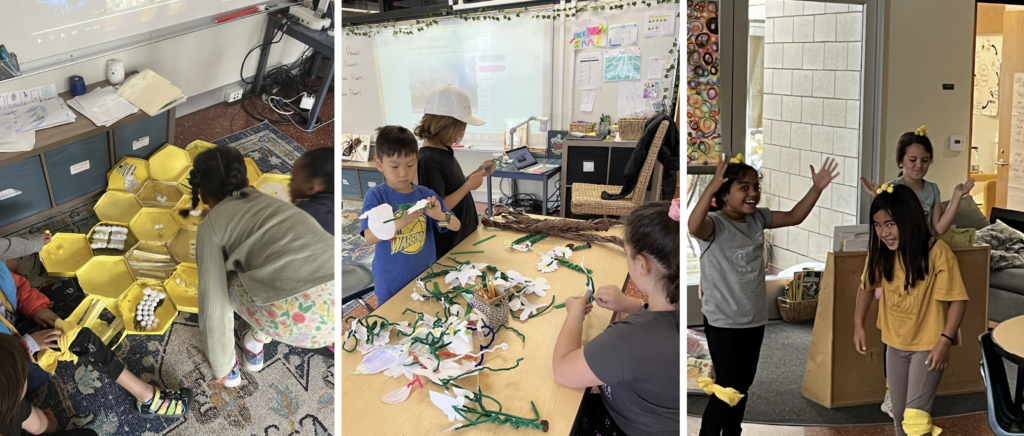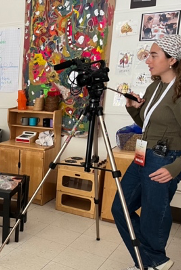Primary Students – 6 & 7 year olds
Bees are incredibly complex creatures. Their perfect hives, symmetry, and intricate group dynamics are a marvel to us humans. Their complex behavior makes them a fascinating subject for study. Over the past year, primary classrooms have collaborated with CONNECT Researcher Dr. Christine Lee to investigate the intersection between plants, pollinators, and people. This blog post dives into one of our most exciting lessons, the Waggle Dance, and why it was an essential part of our educational journey.
Our investigation began with surveying the lab school campus, planting native plants to attract pollinators, studying flowers and dissecting their parts, understanding how seeds transform into flowers, and how these flowers turn into food. This foundational work set the stage for a deeper exploration into the world of pollinators, specifically honey bees. We spent time in the classroom learning about bee hive dynamics, the parts of a bee, and the construction of a hive. Students researched what made worker bees different from drone bees, they learned about the structure and function of bees, and the interdependent relationship between plants and pollinators. Next, students made their own bee costumes where they were able to make creative interpretations of wings and find different ways to represent pollen. We even transformed the classroom into a buzzing hive, with hive cells filled with larva, honey, and mites (see Image 1). The students were then given opportunities to play as bees filling the hive with pollen, protecting it from predators, keeping it clean, and even kicking out the drone bees when “winter” approached.

Students created flowers and a classroom hive (Images 1 & 2). Students pretending to be flowers calling over the bees to pick up their pollen (Image 3).
As our lessons progressed, we turned our attention to the waggle dance—a unique form of communication used by honey bees to convey the location of flowers. This lesson aimed to answer several questions: How do bees communicate? How do they work together? If you found a flower, how would you tell other bees? What happens if a flower does not get pollinated? These questions led us to discuss the broader importance of bees, such as why bees are essential to flowers and people.
To teach the waggle dance, we let the students play as bees but this time with a twist—they could not talk to each other. Before beginning the lesson, we initiated a brainstorming session: “How do you think bees communicate?” The answers varied from buzzing to leg kicking to wiggling. Some students, having researched bees in their own time, mentioned that the wiggling method sounded familiar. So, we adopted a wiggle code, with students creating signals for north, south, east, and west, and even a leg-kicking code for distance.
Image 4. Table of bee communication and movements after first brainstorm.
Students then tried to communicate the locations of various “flowers” around the classroom using their newly devised wiggling dance. They collected pollen and brought it back to the hive, repeating the process until their bee language was refined. They also watched videos of real bees and observed how the dance looked up close. Students learned that the dance conveys critical information about the location of food sources, including distance and direction relative to the sun, highlighting the bees’ complex social structure.
This playful activity was more than just fun—it was a testament to how much the students had learned. It’s important to understand that in order for students to effectively participate, they had to understand complex hive dynamics, the roles of different bees, the process of pollen collection and storage, and the anatomy of bees. Through their play it was clear that they had grasped so much about plant anatomy and pollinators. The intricacies of the wings they built showed a clear understanding of bee anatomy. The way students played as bees, collecting pollen into pollen baskets on their leg and working together to keep the hive in shape were also clear demonstrations of understanding. Beyond the specifics of bee behavior, students grasped the broader ecological significance of bees. They learned about the vital role bees play in pollination and how this affects plant reproduction and food production, deepening their understanding of the interconnectedness of ecosystems and the importance of preserving pollinator populations.
One of the key educational strategies we employed in this project was embodied learning. This is when the meaning of what is learned is grounded in body movement and perception. It leverages the connection between physical movement and cognitive processing to support students’ understanding of complex concepts. Our lesson on the Waggle Dance was not just about movement, but about understanding complex systems and interdependent relationships. By embodying the roles of bees, students tackled systems thinking, comprehending the three-way interdependency between plants, pollinators, and people. By understanding the complex dynamics of bee communication, students gained a deeper appreciation for these remarkable creatures and their crucial role in our ecosystem.

Laila Shaaban is recent graduate from UCLA with a double major in Education and Environmental Science. She has been a CONNECT Research Intern under Dr. Christine Lee’s supervision since 2023. Her interests lie in environmental education, specifically in marine conservation and restoration. She aspires to make an impact through education and community engagement.
This blog post comes from a CONNECT Research study, Climate Literacy through Play and STEAM Education. Questions about this study can be directed to Dr. Christine Lee (clee@labschool.ucla.edu).